

CHD - Coronary Heart Disease Animation. Coronary heart disease - causes, symptoms, prevention. Coronary heart disease occurs when the coronary arteries which deliver oxygen to the heart muscle become narrowed or blocked as a result of the build up of fat/cholesterol within the artery wall.
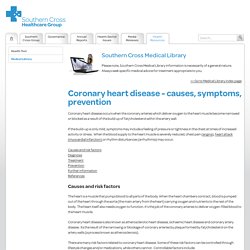
If the build-up is only mild, symptoms may include a feeling of pressure or tightness in the chest at times of increased activity or stress. When the blood supply to the heart muscle is severely reduced, chest pain (angina), heart attack (myocardial infarction) or rhythm disturbances (arrhythmia) may occur. Causes and risk factors The heart is a muscle that pumps blood to all parts of the body. When the heart chambers contract, blood is pumped out of the heart through the aorta (the main artery from the heart) carrying oxygen and nutrients to the rest of the body. Stroke. Stroke Foundation of NZ - reducing risks, improving outcomes. What is high blood pressure. Play our blood pressure animation- press the triangle in the picture above.

As your arteries become narrower and less stretchy, your blood pressure rises. Having high blood pressure means that your blood is moving through your blood vessels with extra force. Over time this can lead to damaged arteries and increase your risk of heart attack and stroke. It can also damages organs like the eyes, kidneys and brain. We don't always know what causes high blood pressure, but it often runs in families. High blood pressure - hypertension. High blood pressure, known medically as hypertension, affects up to 1 in 5 New Zealanders.
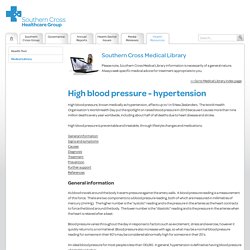
The World Health Organisation's World Health Day put the spotlight on raised blood pressure in 2013 because it causes more than nine million deaths every year worldwide, including about half of all deaths due to heart disease and stroke. High blood pressure is preventable and treatable, through lifestyle changes and medications. General information As blood travels around the body it exerts pressure against the artery walls. A blood pressure reading is a measurement of this force. Blood pressure varies throughout the day in response to factors such as excitement, stress and exercise, however it quickly returns to a normal level.
An ideal blood pressure for most people is less than 130/80. Signs and symptoms There are usually no signs and symptoms of hypertension until the condition has been present for a long time – sometimes for many years. Causes Known risk factors include: Obesity - information for health professionals. Obese children are more likely to be obese into adulthood and to have abnormal lipid profiles, impaired glucose tolerance and high blood pressure at a younger age.
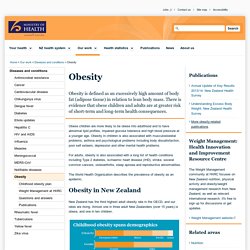
Obesity in children is also associated with musculoskeletal problems, asthma and psychological problems including body dissatisfaction, poor self esteem, depression and other mental health problems. For adults, obesity is also associated with a long list of health conditions including Type 2 diabetes, ischaemic heart disease (IHD), stroke, several common cancers, osteoarthritis, sleep apnoea and reproductive abnormalities.
The World Health Organization describes the prevalence of obesity as an epidemic. New Zealand has the third highest adult obesity rate in the OECD, and our rates are rising. Almost one in three adult New Zealanders (over 15 years) is obese, and one in ten children. For more information about obesity, see Obesity questions and answers. About Type 2 Diabetes. Type 2 diabetes is the most common form of diabetes.
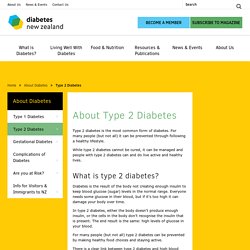
For many people (but not all) it can be prevented through following a healthy lifestyle. While type 2 diabetes cannot be cured, it can be managed and people with type 2 diabetes can and do live active and healthy lives. What is type 2 diabetes? Diabetes is the result of the body not creating enough insulin to keep blood glucose (sugar) levels in the normal range. What is cancer? Symptoms of Colon Cancer. Osteoporosis. Osteoporosis - symptoms, treatment, prevention. Osteoporosis is a condition in which the density and quality of bones is reduced, making them weak, brittle and more likely to fracture.
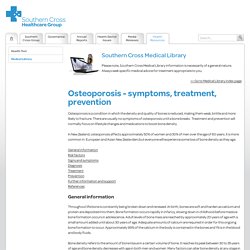
There are usually no symptoms of osteoporosis until a bone breaks. Treatment and prevention will normally focus on lifestyle changes and medications to boost bone density. In New Zealand, osteoporosis affects approximately 50% of women and 30% of men over the age of 60 years. It is more common in European and Asian New Zealanders but everyone will experience some loss of bone density as they age. General information Throughout life bone is constantly being broken down and renewed.
Bone density refers to the amount of bone tissue in a certain volume of bone. Risk factors There is no single cause of osteoporosis but there are many risk factors. There are usually no symptoms of osteoporosis until a bone breaks. Over time there may be a gradual loss in height due to weakened and compressed vertebrae in the spine. 3D Medical Animation - What is a Heart Attack? Causes of Constipation,How to Avoid Constipation?
Obesity is killing this young woman who admits she’s killing herself on TLC’s “My 600 lb life” Story Time - Whats it Like Being So Fat? Morbidly obese, super fat. My 600-LB Life—Junk Food Junkie Marla Is Eating Herself To Death. Celiac diease.